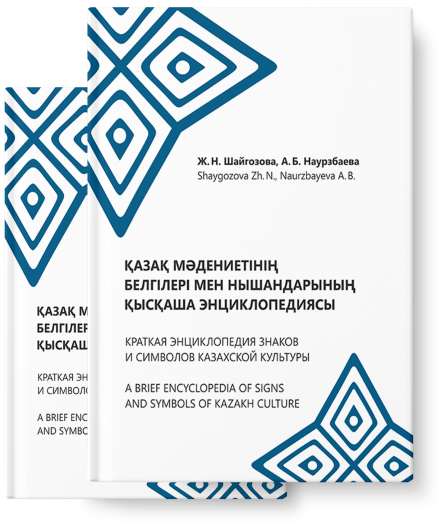
A short encyclopedia of
Signs and symbols of
Kazakh culture

Earrings are among the most diverse forms of jewellery for women in all cultures of the world. Their shape changed as the status of women changed. The very first earrings of Kazakh women were in the form of simple rings, when they got married they became richer and more complicated. Earrings for women of childbearing age were rich in ornaments and decorations (increasing fertility), in advanced age they became one-piece. The high value of earrings was emphasised by the rite of piercing the ears. The Kazakhs have an expression for it: “qulaq tesu – qyzdyñ sundeti” (which means: piercing a girl’s ear is equivalent to circumcising a boy), which illustrates the symbolic meaning of the initiation rite. When putting on the earrings, people usually said, “qūlağyñ auyrmasyn, zhamanshylyq estimei, betiñ azharly bolsyn” -“May your ears not hurt, may they be saved from bad news, may your face be beautiful”. In Turkic culture, girls who were given away were called “syrğaly,” which means “wearing earrings.” As a rule, girls wore earrings with celestial (sun, moon, stars, etc.) and plant symbols (seeds, petals). Their semantics was based on the belief in the purifying properties of the celestial bodies, while the plant jewellery was the oldest fertility symbol. By the shape of the earrings, one could tell whether a girl was single or married. Young women wore dangling earrings with a piece at the end symbolising an embryo, a child. Z. Naurzbaeva wrote with reference to A. Kazhgali uly, “An earring hanging from the earlobe is nothing more than a precious foetus hanging from the thin thread of the umbilical cord…” and “removing the chain connecting the earrings “opens’ ” the married woman’s ear to the possibility of bearing a child.” [8, p.144].
As women grew older, they wore moon-shaped earrings – “ai syrğa,” the shape of the crescent moon being considered a sign of continuity of life. After the age of 40, they were not supposed to wear much jewellery.
Earrings also have a number of functions: protective, reproductive, and charitable. Earrings were a magical object that guarded the ear (one of the entryand exit channels) of the life force – qūt – and, as the research of Z. Naurzbayeva [8] showed, marked an important “channel” of reproduction. Something similar can be observed among the Yakuts – the ear is considered a sacred part of the body, through which people communicate with the gods. Evil spirits can enter a woman’s soul through the ear. It was believed that a snake can crawl into her ear. On monuments in Western Kazakhstan there are images of women’s jewellery, which can be taken as a symbolic amulet for the beloved in the “other” world.
In traditional Turk culture, earrings were also worn by men. They usually wore a single earring in the left ear as an amulet or talisman of protection, and in some cases as a special sign to emphasise military status.

